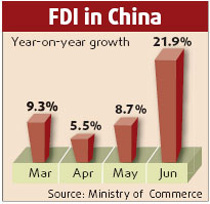Chinese brands are growing at a rapid pace, with some of them getting international recognition, concludes a report by Samsung Economic Research Institute (SERI), citing AOC and Chery as examples.
AOC has become a major manufacturer of monitors thanks to vigorous efforts to establish its own brand.
Consumer surveys of SERI showed interest in AOC's brands leaped to 12.3 percent in the third quarter of 2007 in China, from 4.3 percent in January 2005, while its market share jumped to 21 percent in September 2007 from 13.3 percent in January 2005.
AOC is now emerging as a credible competitor against foreign monitors and is in a position to challenge established leaders like Samsung and LG.
Automaker Chery has also been busy establishing an independent brand image. According to a survey conducted jointly by Interbrand - a global brand consultancy - and Business Week, Chery is now one of China's foremost brands, rivaling Haier, Lenovo, Tsingtao and Huawei in recognition.
Chery sold 300,000 vehicles in the first nine months of 2007 for the top spot among domestic Chinese auto brands and is slowly emerging as one of the nation's premier automakers, capable of challenging Shanghai GE, FAW-Volkswagen and Shanghai Volkswagen.
Originally a parts maker, the firm shifted into full auto production in the past 10 years. Chery's cumulative output topped 1 million units this year.
After focusing on small vehicles in its initial days, Chery has expanded its product line to focus more on Class-A heavy vehicles. Small vehicles such as the QQ took up half of Chery's total sales till 2005. The sales share of QQ, however, fell to 20 percent last year while sales of Class-A vehicles has risen to 58 percent from 34 percent in 2005.
Key factors
Successful local brands have built their brands in stages, generally by establishing R&D systems through a technological joint venture and then proceeding to develop an industrial chain through a capital joint venture that enables the creation of a diverse product base.
The first step for the development of independent brands is to increase production through greater productivity. Companies that can combine product reliability and low production costs are on their way to securing formidable market positions. AOC and Chery both attained market advantages in specific regions by providing reasonably priced, high-performance products.
AOC established a "pentagonal" product supply chain by linking its five major production complexes in Beijing, Fujian, Wuhan, Suzhou and Ningbo. Chery improved its productivity by setting up seven factories in Russia, Ukraine, Iran, Egypt, Indonesia and Uruguay.
R&D system
The second stage of Chery's establishment of branding power saw an independent R&D system through a technology joint venture. Chery pursued "open and independent technology innovation" through an alliance with Austrian engine maker AVL in 2002. This resulted in the design of 1.8- to 4- liter engines, which complied with Class IV vehicle emission standards in Europe.
At the Shanghai Motor Show held in April 2005, Chery showcased a world-class engine developed in-house, drawing accolades from the auto world. It also pushed for a technology joint venture with a number of prominent firms in Italy and the UK to improve its designs, testing, and chassis development.
The third step is to establish an industrial chain through a capital alliance. Chery set up joint ventures with a handful of domestic and foreign companies to further promote product sales and production.
It established a joint venture with Quantum LLC in May 2007, aiming to boost sales of middle- and high-class vehicles by using Quantum's strong overseas marketing capability. By collaborating with domestic companies, Chery has built several sales agencies, moving closer toward vertical integration of its sales channel and enhancing its influence over the sales channels of rivals.
Well aware of potential pitfalls on the way to greater brand recognition, AOC has taken precautionary measures through partnership with local parts makers. It set up factories jointly with Chunghwa Picture Tube and Chimei to ensure a stable supply of panels.
To improve its brand recognition, AOC established its own "VI Image Shop". AOC also started an "Urban and Rural Greenfield Project" in 2007, aiming to enter the third- and fourth-level markets.
Such efforts bumped up the company's market share and helped it diversify its product lineup, laying a solid foundation for higher brand recognition. The company went on to acquire the "Maya" brand from Guangzhou Maya LCD in October 2007, bringing its total number of brands to four - Maya, Envision, TOPVIEW and AOC.
Chery, meanwhile, maintained its market share through a diverse product lineup, coupled with efficient brand strategy. Its flagship brands, including QQ3, Cowin, A5 and Eastar, have enjoyed stable growth over the past few years, while sales of its new brands, including A1, QQ6 and Eastar Cross, are growing at a steady pace.
Suggestions
Given that the establishment of independent brands and the improvement of brand value are a lengthy process, businesses need to implement their brand strategy in a more scientific and accurate manner.
Firms like AOC and Chery that have succeeded in building their own brand identities have improved their brand value through market segmentation. In turn, they also perform the role of marketing ambassadors for "Made in China" products, clearing the way for other Chinese entries in the global market.
Apart from AOC and Chery, Nanjing Automobile Group has also made noteworthy efforts to improve its brand equity by acquiring the Rover production line and the MG brand from MG Rover of the UK in July 2005.
Despite the recent successes, however, local companies still need to take a prudent approach in building their own brands. In spite of low production capacity, some local companies have already thrown excessive resources into brand-building.
Panda, for example, spent 100 million yuan to advertise its mobile phones during primetime TV hours. Although this gained it the reputation as the "King of Advertising" in 2003, Panda's finances suffered, causing it to eventually fail in the mobile phone business.
(China Daily February 22, 2008)


